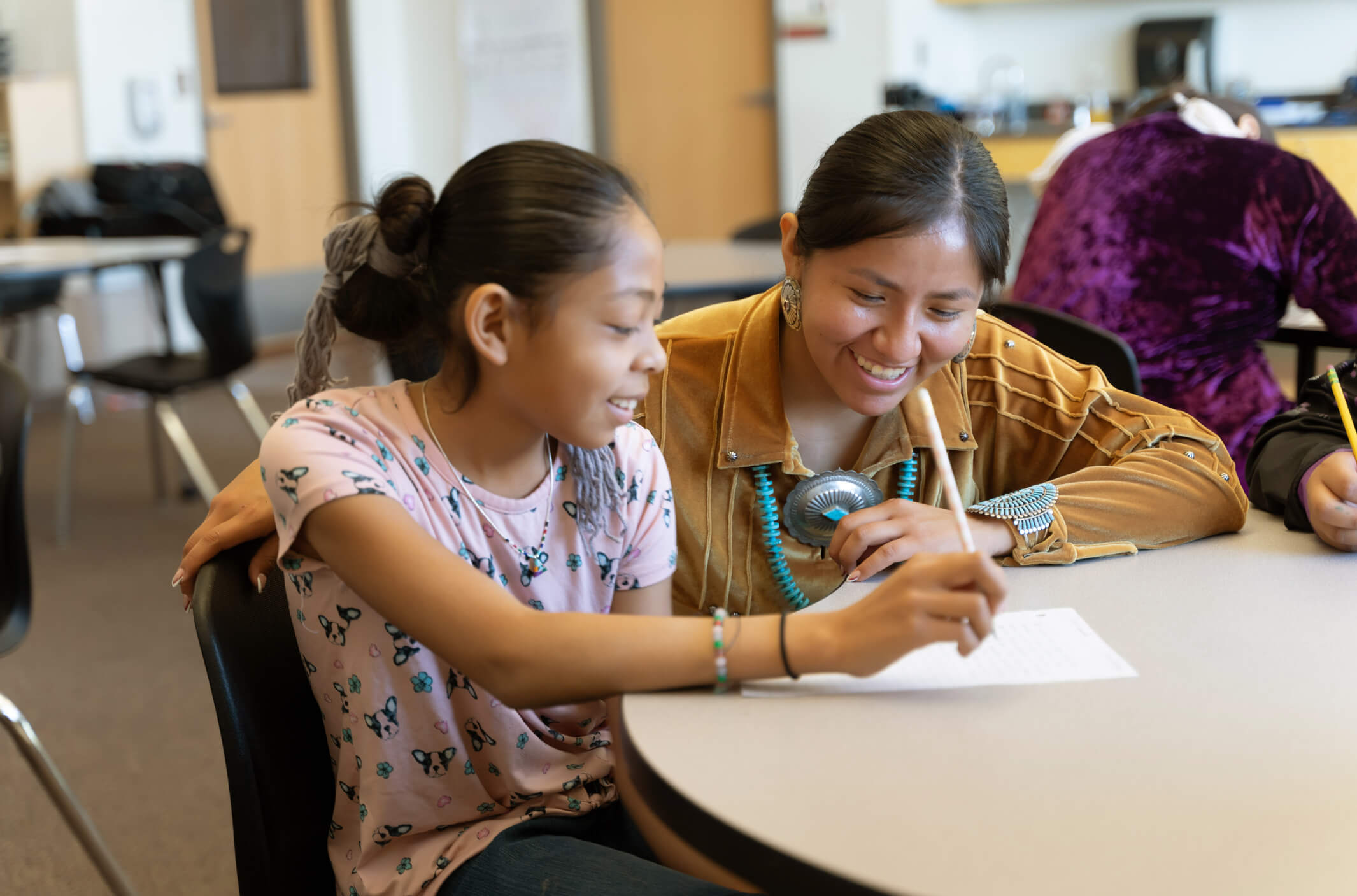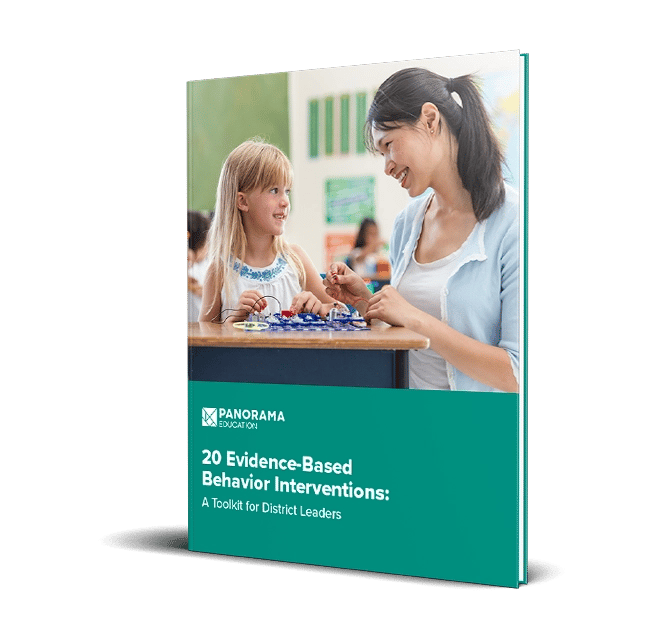We know that holistic student success and behavior challenges are linked. When students experience academic challenges, they are more likely to exhibit unwanted behaviors, and vice-versa.
Managing behavior in schools has always been a challenge. However, many educators have seen a sharp rise in serious classroom behavior incidents since the pandemic. So finding ways to create positive, productive learning environments is crucial.
PBIS and Student Behavior
To meet this challenge, many school districts are implementing a PBIS framework (Positive Behavioral Interventions and Supports). When the framework is implemented well, it benefits the entire school community:
- Students achieve improved social and academic outcomes.
- Schools see fewer office discipline referrals and reduced use of exclusionary practices like suspensions.
- Faculty and staff members feel more effective.
By promoting positive behavior in the classroom, we can also move the needle on academic success, attendance, and life skills.
Download 20 Evidence-Based Behavior Interventions: A Toolkit for District Leaders
PBIS and Your MTSS
PBIS is a part of an overarching MTSS, providing tiered behavior support for students. Districts often implement PBIS as part of their holistic MTSS approach. Tiered interventions form the foundation of a strong PBIS:
- Tier 1 (universal): These interventions include school-wide expectations and supports established for all students and educators across all settings. Schools and districts establish Tier 1 behavior practices for all students, with the goal of decreasing the number of escalating behavioral issues that require additional intervention.
- Tier 2: These interventions provide slightly more targeted support to prevent serious behavior challenges before they start. Tier 2 interventions are designed for some students, and are often given individually or in small groups.
- Tier 3: Tier 3 is the most intensive, with few students receiving these supports. These individualized supports address severe behavioral challenges and often involve the work of a behavior specialist.
Finding high-quality, evidence-based MTSS intervention strategies can be challenging for educators and school teams. Teachers may feel overwhelmed by hours of research, and uncertain if certain strategies are appropriate for their students. Even when teachers and PBIS teams do have access to an intervention library, it may lack key resources, such as implementation guides or fidelity checklists.
In this guide, you'll find five evidence-based behavior strategies with facilitation guides or fidelity checklists. These strategies, taken from Panorama's Playbook, are proven effective through empirical studies. Incorporate these strategies into your district-wide intervention menu and share with your school teams.
- Classroom Reset
- Turtle Technique
- Daily Behavior Report Card
- Classroom Buddies
- Mystery Motivator + Fidelity Checklist
|
|
5 Behavior Strategies for Your MTSS
1. Classroom Reset
Classroom expectations are presented to students using a three-step process to maximize their acquisition.
-
Focus Area: Classroom Expectations
-
MTSS Tier: Tier 1, Tier 2
-
Developmental Stages: Upper Elementary, Middle School, High School
Action:
Preparation:
- Identify or create a Reset Space in the classroom. If you already have a peace corner, calming corner, or similar space setup, that will work perfectly!
- Click here to access the facilitator guide.
Instructions:
This strategy is designed to be used in lieu of warning-based behavior management systems and, instead, provide opportunities for educators and students to “reset” and interact positively. There are typically five components of a Classroom Reset:
- Catch Phrase. The teacher selects a short verbal statement or term that will prompt their students to self-monitor and self-manage their behavior. The catch phrase should be a pre-taught, modeled, and practiced reminder that students are familiar with. In other words, the catch phrase should prompt students to think: “how do I manage my behavior right now?”
- Reset. If a student (or students) continue to require support with self-managing specific behaviors, the teacher can prompt them to move to the “Reset Space” in the classroom. This can be done by dropping an object on the student’s desk or making eye contact. Moving to the “Reset Space” allows the student an opportunity to take a few moments to recalibrate and utilize calming strategies, such as deep breathing or having a snack.
- Reflection. After the student has calmed down, the teacher prompts the student to reflect on their behavior, asking questions such as: What was my behavior? What behavior do I need to display?
- Debrief. During the debrief, the student and teacher discuss the behavior(s) displayed and the questions from the reflection. The debrief allows the student and their teacher to process the behaviors and discuss a plan for how to move forward.
- Instructional Re-Entry. Students are able to transition out of the “Reset Space” once they feel ready to self-regulate and self-manage their behaviors. The teacher then helps the student re-engage in academic work.
2. Turtle Technique
This calming strategy helps teach students a set of concrete, easy-to-remember steps they can use to both identify as well as manage their feelings. The Turtle Technique is also a self-regulation practice that teachers can share with students’ family members.
- Focus Area: Self Management & Regulation
- MTSS Tier: Tier 1, Tier 2
- Developmental Stages: Lower Elementary, Upper Elementary
- Goal: Provide students with visual and scaffolded pre-writing, or planning, support
Action:
Preparation:
- Click here to download the facilitator guide for this strategy.
- Explain to your student(s) that you will be teaching them about a new tool that they can use to work through hard situations with lots of big feelings.
- Share that the name of this tool is the “Turtle Technique” – because they are going to learn how to “go inside their own shell” to find calmness.
- Model the Turtle Technique for students:
- First, recognize your feelings. What are some words that you can use to describe what you’re feeling? How is it showing up in your body?
- Then, think: “stop” and go inside your shell, taking a few deep breaths. Start to think about solutions.
- Finally, you can come out of your shell when you’re feeling more calm.
3. Daily Behavior Report Card
The Daily Behavior Report Card (DBRC) is a method used to document and give feedback to students on their behavior. DBRC includes clear target behaviors, periodic judgment of the target behavior, a system of daily monitoring, and a communication component between school and home.
The DBRC is used to increase communication between home and school, provide structure and consistency for student behavior, and increase students’ motivation and effort. They can be integrated into typical teaching responsibilities without the need to count or monitor behavior consistently throughout the day.
- Focus Area: Motivation
- MTSS Tier: Tier 2, Tier 3
- Developmental Stages: Lower Elementary, Upper Elementary, Middle School, High School
Action:
Preparation:
- Decide on the main areas of improvement (e.g., turning in assignments, less disruptions during class, improve peer relationships) by reviewing the students current behavior and goals.
- Operationally define the target behaviors.
- Include specific criteria (e.g., fewer than 5 disruptions per class, completes all assignments within allotted time, calls out less than 2 times per class).
- Establish the rewards/privileges the student will earn at school and/or at home if the goals of the DBRC are met.
- Determine the interval for reviewing the students’ behavior.
- Send report card home to parents daily or weekly.
- Create a behavior form/chart/report card that includes the above information.
Instructions:
- Complete the preparation steps with the parents and students involved.
- Explain the DBRC to the student.
- Consistently use the DBRC at the predetermined intervals to rate and review the student’s behavior with the student.
- Send home the DBRC on the predetermined interval and have parents sign and return the report.
- Monitor and modify the program as needed.
4. Classroom Buddies
Classroom Buddies is a peer intervention program that is designed to intentionally create opportunities for students to get to know one another, form connections, collaborate, and learn together.
- Focus Area: Social Skills
- MTSS Tier: Tier 1, Tier 2
- Developmental Stages: Lower Elementary, Upper Elementary
Action:
Preparation:
- Create a system for assigning buddies and pairing students together. Pairings should change each week. Share this on a poster with students at the beginning of each week.
- Determine how many times per week you will have established Classroom Buddy time built into the schedule.
- Click here to download the facilitator guide for this strategy.
Instructions:
- Before the first Classroom Buddies session, share some details about how it will work.
- Students can check their Classroom Buddy pairing at the beginning of each week. Everyone will have the opportunity to pair with each member of the class.
- Students will complete short, fun activities with their buddy.
- Share the Classroom Buddy assignments for the first week.
- During predetermined Classroom Buddy times, share a short activity or icebreaker with the pairs. These should be supportive of having students work together and get to know each other (e.g., solving a puzzle; working on an art project).
5. Mystery Motivator + Fidelity Checklist
This intervention is designed to serve as a systematic reinforcement plan that helps motivate students to engage in tasks they are avoiding.
- Focus Area: Positive Behavior Reinforcement
- MTSS Tier: Tier 3
- Developmental Stages: Lower Elementary, Upper Elementary
Action:
Preparation:
- Brainstorm a list of a student’s preferred reinforcers.
- Materials: notecards; chart or poster paper; reinforcers.
- Access the implementation fidelity checklist as a Google Doc or PDF.
Instructions:
- Co-create a list of reinforcers with a student. You can share some reinforcers that you have brainstormed and see what resonates or does not resonate.
- Adapt that list into a mystery motivator chart.
- Write the student’s name on it and draw spaces for each day of the week.
- Randomly write M next to a few days of the week. Cover each day with a notecard so that the Ms are covered.
- For each note card placed over an M day, write a motivator on the back of the card (e.g., homework completion, 80% accuracy on math quiz).
- Define motivators/goals for the student. These can be behavioral or focused on academics.
- Explain that each day, the student will be prompted to focus on their goal. If they meet the criteria, the teacher will let them know and they can remove the notecard from the mystery motivator chart.
- It is important for educators to make this reveal (notecard removal) an exciting event.
- If the student flips the notecard and reveals an M behind it, they will receive a reinforcer as soon as possible. If there is no M, praise them for their efforts and encourage them that they may uncover an M on another day—there will be more opportunities to earn the mystery motivator!
Next Steps for School and District Leaders
District Leaders can incorporate these strategies into district-wide intervention menus, and consider ways to consistently implement interventions districtwide. School leaders, consider bringing these strategies to PLCs, staff meetings, or MTSS and Student Support team meetings to share with staff and support students at every tier.
If you're looking for additional behavior interventions, download our free toolkit of 20 evidence-based interventions. Each strategy provides detailed instructions, and many include fidelity checklists—so educators can feel confident in their implementation of each intervention.






.jpg)
